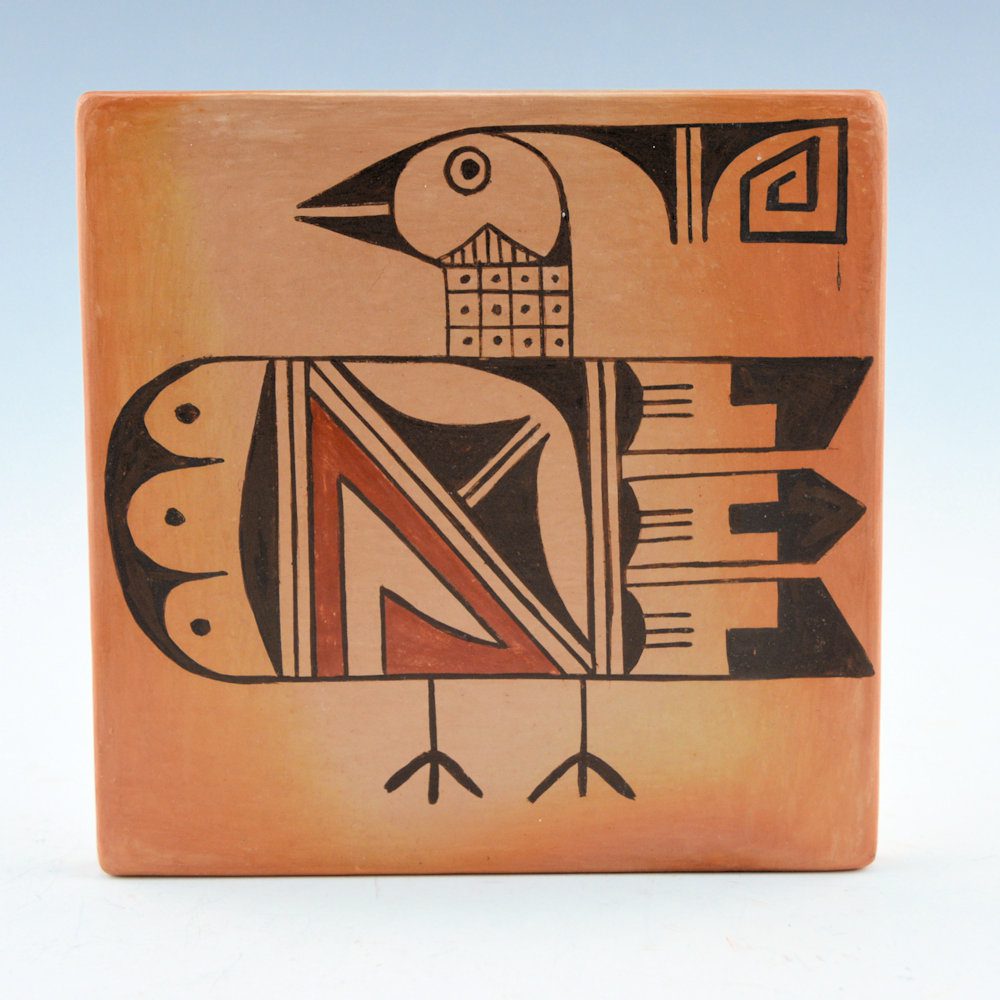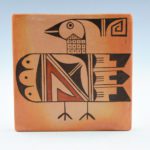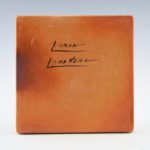This bird is part of a flock of folk birds that regularly adorn Hopi and Hopi-Tewa pottery, cf 1998-10, 2002-10, 2007-13 and 2008-05. Lorna’s tile is indistinguishable from the work of her mother, Sadie Adams, who for decades demonstrated pottery making and won many awards at The Museum of Northern Arizona.
Form:
The tile is perfectly square and somewhat thicker than the typical Hopi tile, giving it some heft when picked up. It carries a beautiful golden blush from the outdoor firing. One edge on the rear is slightly burned where the fire touched the tile, a certification of authenticity.
Design: The design is a single bird, or more technically an “Acoma-influenced D-shape breasted bird with cartridge-like eyes, tufted head feathers, triangular slit beak, and elaborate back-thrusting tail feathers” (Wade and Cooke, 2012:183). As detailed above, this general form is not rare for birds images on pottery formed at Hopi and seems derived from Acoma-style birds of the sort seen on seedjar 2015-03. From the D-shaped breast the edge of the body flows smoothly toward the rear where it morphs into distinct feather points.
The head is an oval with a circular eye and black pupil. The beak a black triangle, bifurcated. From the top of the bird’s head flies a top knot. The central section of this banner is somewhat like the cross-section of an upside-down volcano, two curved slopes around a central vent, except that the vent has a single black line at its center. The top knot terminates with a squared-off crook with 8 turns of varying degrees.
The neck consists of three rows of four squares, each square containing a dot. This pattern is sometimes said to represent a field of corn. Above the neck, and intruding into the face, is a small triangle contain ing 7 vertical lines.
The body, oversized for the head and legs, has three design sections separated by two unpainted vertical areas containing a single line, “two-lane highways.” A third two-lane highway runs diagonally through the central section of design, connecting the parallel highways, and thus creating a capitol “N” of highways at the center of the bird’s body. If Superman is recognized by the large “S” on his chest, this bird advertises itself as “N-bird.”
The curved breast section is most easily seen as three unpainted “thumbs” or hills set into an otherwise black background. Each thumb contains a single black dot. Alternatively, the black background can be seen as the design: two thin pointed elements facing toward the rear with black dots floating on the three sides of the points; a low black hill based on the far wall. The viewer’s eye flips between these two views, a technique called “background/foreground reversal” which energizes the design.
The middle section of design is square with the sloped cross-piece of two-lane highway “N” running from upper-left to lower right and thus dividing the space into two triangles. Both triangles display “background/foreground reversal” designs. The lower segment can be seen as all red with an unpainted, somewhat “V-shaped,” form set in to it pointing up. The left leg of this form is rectangular while the right arm is triangular. Alternatively (image reversal), the design can be seen as a large red crook with a hill-shaped, pointed end. The center of center this crook is unpainted. The upper triangle contains another volcano-like element, two sloped sides with a single line in the vent. This is the same element we saw in the top knot but with a different orientation. The upper right corner of this section displays a curved black form that mirrors the shape of half of the volcano above (in the top knot) and (with a different orientation) half the volcano below.
Following another two-lane highway, the rear is composed of three tails. All three begin with a low black hill with three parallel projecting lines, what I have called “gumdrop hills with whiskers” when used by Nampeyo (Appendix F). An unpainted space follows. The center tail has a black point consisting of a short shaft caped with a triangle. The flanking two tails have somewhat larger black tips, but it is as if the tip of the central feather had been split with the lower half floating up to be attached to the top arrow and the remaining half sinking to be attached to the bottom arrow. The straight cut edges of these feathers are part of the smooth outline of the body, with the result that both flanking feathers have tips that slope toward the central feather, drawing the viewer’s eye toward the center of the design.
With its elaborate top knot, the head of the bird is elegant. The massive body carries a complex and impressive design. That this structure is carried by two spindly legs consisting of a single lines, each branching into three toes is ridiculous and adds humor to the design. Having visited Hopi for 60 years, I am impressed by the elegance and strength of its culture and recognize that day-to-day interactions between people are often humorous. This tile well represents that origin, and I smile.
I purchased tile 2020-12 from King Galleries and they commented:
“Lorna Lomakema is a daughter of noted potter Sadie Adams. She began making pottery in the 1970s’ but no longer make any work in clay. This is one of the few tiles we have seen of her pottery. It is painted with bee-weed and red clay slip. It is a classic style Sikyaktki or Hopi bird. The tile was traditionally fired which created the blushes on the surface. It is signed on the back, “Lorna Lomakema”. It is in excellent condition with no chips, cracks, restoration or repair.”



